|
Spring 2019
In this issue

Written by: Jonathan Hanft
I hope everyone is staying warm and enjoying the beautiful snow. Get out and take in the view before it’s gone, and perhaps do some snowshoeing, skiing, or take a nap in a snow cave.
2018 was a successful year because of the great work that you do. Enrollment in Ryan White Program services is increasing, which means more people have better health outcomes. Enrollment in the services you provide is critical to increasing retention in care and viral suppression rates because we know that Minnesotans living with HIV do better when they receive the support you provide. Hopefully many of you will be involved in our upcoming efforts to reach the estimated 24 percent of the population of people living with HIV in the 13-county Minneapolis – St. Paul Part A grant area who are eligible for, but are not receiving Ryan White Program services.
Please take a few moments to read on and dream about the crocuses that will pop up sometime in the not too distant future.
|
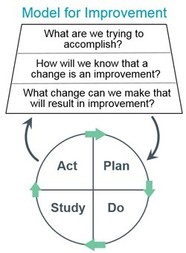
Written by: Anika Kaleewoun
Have you ever tried a different route to work, to school, to the grocery store? Why change? Our reasons may be different – to reduce time on the road, to save gas, to avoid traffic, to reduce your environmental impact, to take a scenic route, or to enjoy a smoother ride.
Maybe Waze or Google Maps informed you that this new route will save you 10 minutes. Maybe a friend told you that the sunrise over the greenway is gorgeous. We get recommendations from different trusted sources. How do you know if your new route was better than your previous route? You probably don’t document the change but do take a mental note about which route you will take in the future and why. In our everyday lives we test out new ways of doing things without even thinking about it.
Now apply this to your work. As you plan out your week, month, or year, take some time to write your goals. Reflect upon last year. What didn’t work? What could you improve? Recall the example above. Do you want to get your work done more efficiently or faster? Do you want to use less resources? Do you want the work to look different? Do you want to make this year easier or smoother? This is your step one in the Model for Improvement.
Now you will need to figure out how you are going to measure it. How did you describe what happened last year and what you want to improve this year? Find an indicator that you can measure and that you can use to track your progress toward your goal. In the improving your commute example above, measurement could be time or gas used getting to your destination, it could be how much less maintenance or replaced parts do you need thanks to the smoother route, or it could even be your blood pressure upon arrival at your destination after taking a more beautiful route that does not have as much traffic. Be creative but also realistic, what measure matters to you most? This is your step two in the Model for Improvement.
Next up, you are going to have to figure out how are you going to actually get to your goal. What actions, steps, tactics, strategies are going to help you improve this year’s performance over last year’s? Make sure to not bite off more than you can chew. Learn from experts, peers, or your quality manager about what has been proven to work elsewhere. Seek input from your team because some of the best wisdom is from those doing the work every day. Be realistic about what you or your team can accomplish. Write down precisely with as much detail as you need the path that will get you from where you are at today to a better outcome by the end of the year. This is your step three in the Model for Improvement and your first step in the Plan-Do-Study-Act (PDSA).
Now you are ready to try your new idea or intervention. Test it out, on a small scale. Write down what happened, what you observed. Reflect on the results – did your new idea work? Did it help you get closer to your goal? If so, keep it up, scale your idea up. If you think you can do better you might want to adjust or adapt your plan. Or if your new idea was a total bust, start over with a new good idea. Adopt, Adapt, or Abandon your new idea and do a new PDSA cycle. Never stop testing, trying, learning and improving!
If you are a Ryan White consumer or provider and want help figuring out how to use the Model for Improvement in your work, contact Anika at anika.kaleewoun@hennepin.us or 612.596.7895.
|
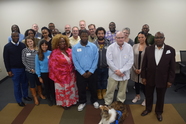
Written by: Jeremy Stadelman and Carissa Weisdorf
Goodbye to members rotating out
The Minnesota Council for HIV/AIDS Care and Prevention said goodbye to several members this month who completed their two terms on the council. David Neller, Gelli Overton, Val Rubin-Rashaad, and Matt Toburen have been on the council since its launch in 2016 as an integrative body. We hope they all remain involved with the council as community members and, after one year, they are eligible to reapply for membership. The council plays a critical role in the development and continuous improvement of the system of care and prevention for people living with, or at risk for, HIV/AIDS in Minnesota. The hard work of individuals like David, Gelli, Val, and Matt is essential in this effort.
Recruitment of new members
The council will be welcoming new members in March, and there are several membership spots that still need to be filled. Specific communities that we are seeking applicants from include:
- Trans women, trans men, and gender non-binary individuals who are living with HIV and not affiliated with an agency receiving Ryan White Part A or Part B funding (unaligned consumers)
- Hispanic or Latino men who are living with HIV and not affiliated with an agency receiving Ryan White Part A or Part B funding (unaligned consumers)
- Native Americans who are members of a federally recognized tribe.
- The council is also in need of a State Medicaid agency representative
If you are from one of the underrepresented communities or categories or know someone who is, please consider applying to the council or sharing the application, which is available online.
Upcoming elections
In January, the Membership and Training Committee forwarded a slate of six candidates to be considered for council membership, and the council held an election at the February 12 meeting. The new members will begin their two-year terms on March 1, 2019.
An orientation will be held for new members on March 1, 8 a.m. to 12 p.m., and anyone is invited to attend to learn more about the council.
The Membership and Training Committee has also developed a mentoring program for new members, so each new member can be paired with a current member who will help to facilitate understanding of the purpose, activities, and procedures of the council. The goal of the mentoring program is to expedite support and tutoring so that new members will achieve comfort in their membership role as quickly as possible.
|
Hennepin County’s Part A grant award for fiscal year (FY) 2019 (March 1, 2019 – February 29, 2020) is $5,837,443; a decrease of $25,424 compared to FY2018. This is the third year in a row we’ve received a small decrease in funding. Ryan White HIV/AIDS Program federal appropriations have been essentially flat for the past decade.
As this graph shows, we are again at a point where Part A funding is not keeping pace with the increase in HIV prevalence in our 13-county Part A grant area.
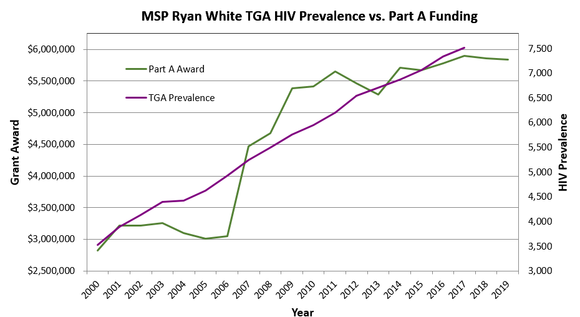 Although this year’s decrease in funding will not result in a decrease in Part A funding for services in FY2019, if a decline in funding continues in future years, the Minnesota Council for HIV/AIDS Care and Prevention may need to decrease Part A allocations to some of their service priorities.
The Kaiser Family Foundation is a great resource for following trends in federal HIV funding and the epidemic overall: https://www.kff.org/hivaids/
In updating Minnesota’s 5-year Integrated HIV Prevention and Care Plan, the Minnesota Council for HIV/AIDS Care and Prevention added an objective to increase the proportion of people living with HIV in Minnesota who receive Ryan White Program services from 50 to 60 percent. Our Part A 2019 quality management plan includes this as a goal as well.
Why? Because people living with HIV who are enrolled in Ryan White have significantly better health outcomes (retention in care and viral suppression) compared to the population of all diagnosed people living with HIV.
Those of you who have been involved in our EIIHA (Early Identification of Individuals with HIV/AIDS) efforts over the past several years are invited to participate in a technical working group to develop recommendations on how to increase enrollment in the services we fund. The good news is that preliminary Ryan White Program data from CAREWare for calendar year 2018 indicates that because of your dedicated hard work we’ve increased the number of clients who received services (all funding sources: Part A, B and rebate) in 2018 by almost 6 percent compared to 2017.
Written by: Mona Deoferio and Walter Urey
Contracts for fiscal year 2019-2020 are currently being finalized and will be sent to providers soon. Contracts will be sent to the signatory via the Electronic Contracting Process. Please remind your signatory to sign electronically, as paper contracts are no longer accepted. If you have any questions regarding your contract, please contact your contract manager.
Mona Deoferio
Walter Urey
Written by: Ryann Freeman
After almost a full year with the newly developed standards of care around cultural responsiveness in place at all Ryan White funded agencies, we are eager to review baseline data of demographics served by service area at a systems level. A few reminders for providers:
- Please remember to log all training hours completed for staff around cultural responsiveness – the new standards require at least four hours of training for at least one staff member per service area
- Please complete the client input survey before the end of the fiscal year. If you receive funding for Part A and Part B, you are welcome to use the latter fiscal year as a deadline. You can find copies of the client input survey around cultural responsiveness on the provider Basecamp site, where there are six different versions to accommodate preferred languages.
Reach out to Ryann Freeman with any questions about these new requirements to make sure you are compliant with the new cultural responsiveness standards of care: ryann.freeman@hennepin.us

This winter, Positively Hennepin’s work to end the epidemic included a World AIDS Day community conversation and working with grassroots leaders to secure federal funding for building capacity to eliminate HIV.
For World AIDS Day 2018, Positively Hennepin and Red Door Clinic hosted a community conversation on how Hennepin County’s diverse residents can unite in a journey towards ending our epidemic. The event was held at the Parkway Theater in South Minneapolis and featured storytelling from residents living with the virus and a discussion on what our communities need to stop the virus, to keep positive folk healthy, and to end HIV discrimination. The West African HIV Task Force, Red Door Clinic, Youth and AIDS Project, and Indigenous People’s Task Force all brought their expertise to the talk. Confronting racism and homophobia, and solutions for affordable housing and mental-health challenges were paths to ending the epidemic that were explored during the event. Check out the Minnesota Spokesman-Recorder and KSTP Channel 5 News for coverage of our community conversation.
One of Positively Hennepin’s three goals is to engage and facilitate the empowerment of communities that HIV hits hardest to stop new infections. These communities have also identified HIV-awareness campaigns as essential to ending the epidemic. To meet this need in a way that meets our strategy’s community-engagement goal, Positively Hennepin recently partnered with All God’s Children Metropolitan Community Church, the West African HIV Task Force, and Sub-Saharan African Youth and Family Services to apply for a first-of-its-kind funding opportunity from the U.S. Department of Health and Human Services (HHS).
If successful, our application would fund community-engagement with African American, same-gender-loving men and East and West African communities to build stigma-busting and educational HIV targeted awareness campaigns. We expect to hear from HHS on the status of our application by early summer.
|
Written by: Thuan Tran, Ryann Freeman, and Jonathan Hanft
Native American community engagement
In 2018 a capacity building project provided by the Office of Minority Health Resource Center (OMHRC) and Kurt Begaye Consulting was developed with the following objectives:
- Strengthening capacity of the Hennepin County AI/AN Workgroup through education and increasing awareness of HIV and PrEP access and treatment.
- Improving strategic partnerships with community networks and Tribal agencies to provide resources to assist with medical care, medical case management, early intervention services (EIS) and other services within the system of HIV care and prevention.
- Identifying strategies for integrating the PrEP and EIS education into services being provided by tribal health agencies and provide best practices and culturally appropriate HIV care and prevention services.
Additionally, Elton Naswood, Senior Policy Analyst, OMHRC and Kurt Begaye Consulting engaged the AI/AN community in Minneapolis to assess the community climate and needs regarding HIV testing, prevention, and care services, as well as PrEP education and resources. To help facilitate this process, a questionnaire was developed and implemented with key informants in the Minneapolis AI/AN community. Naswood and Begaye are returning on March 7 and 8 to support the development of a community action plan.
Minnesota People of Color Pride – HIV community testing pilot project
In 2018, Hennepin County’s Ryan White Program initiated a pilot early intervention services (EIS) project to help engage community in testing a hard to reach yet disproportionately affected community: African American same gender loving/MSM men. Through collaboration with the Aliveness Project, Minnesota People of color Pride began administering EIS through peer testing and counseling to help reach African American SGL men, the most disproportionately affected community by HIV in the state of Minnesota.
Minnesota People of Color Pride achieve their testing goals by collaborations with other EIS providers, and they are always looking for more coordinated efforts. Please reach out to Raymel Givens or Dennis Anderson to learn more about their pilot project: mels3250@gmail.com; mwhswm@gmail.com.
West African AIDS Task Force
Through capacity building funding provided by the Minnesota Department of Human Services, the West African HIV Task Force continues to engage the Twin Cities’ West African communities in HIV community action planning and HIV education and testing through regular Task Force meetings, training of peer women educators and faith leaders, and community outreach events. The Task Force has formed partnerships with Ryan White Program funded providers and the Minnesota Department of Health. Through her tireless effort and passion, Hennepin County Public Health intern Emma Boyce has been instrumental in supporting the Task Force and their work to mobilize our local West African communities to end new HIV infections.
Hennepin County Ryan White Program staff attended the National Ryan White Program Conference at the National Harbor in Maryland in December. Minnesota Council for HIV/AIDS Care and Prevention co-chair Tyrie Stanley, along with four Hennepin County Ryan White Program staff authored or co-authored the following presentations and a poster at the conference:
- Three Approaches to Achieving Quality, Culturally Responsive Care – Ryann Freeman, Thuan Tran
- Advancing Health Equity through Community-Based Participatory Research – Thuan Tran, Tyrie Stanley
- Measuring Clients’ Movement along the Treatment Cascade Using Multivariate Analysis – Aaron Peterson
- Data-to-Care Strategies Utilized by Ryan White HIV/AIDS Program Part A Recipients in the Care Continuum Learning Collaborative – Jonathan Hanft
At the conference we learned that nationally, the Ryan White Program client retention in care and viral suppression rates are increasing over time:
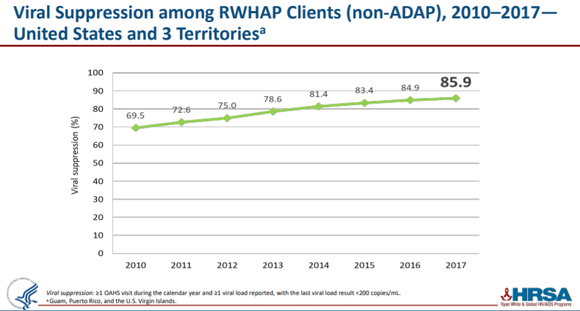 And disparities among disproportionately impacted populations are decreasing:
 You can find a recap of the conference and peruse the presentations here: https://targethiv.org/calendar/national-ryan-white-conference#plenary
Written by: Aaron Peterson
 * Populations under 100 people were not released due to Minnesota Department of Health privacy policies.
Health equity continues to be a top priority of the Ryan White program. Despite lingering disparities, there is good news. Across all demographic groups defined by the Minnesota HIV Council, retention in care is consistently 95 percent. This speaks to the hard work of the Ryan White providers who help meet the core medical and support service needs of Ryan White clients -- allowing these clients to stay engaged with HIV medical care.
Moving along the HIV care continuum, the challenges to health equity emerge. African American MSM and African American women both experience significant disparities in viral suppression, despite being retained in care at comparable rates as other demographic groups. Closing these gaps will require concerted efforts from the Ryan White government recipients evaluating system level barriers to care, providers continuing their work to deliver culturally responsive services, and engagement with these communities to understand (and then, meet) their needs.
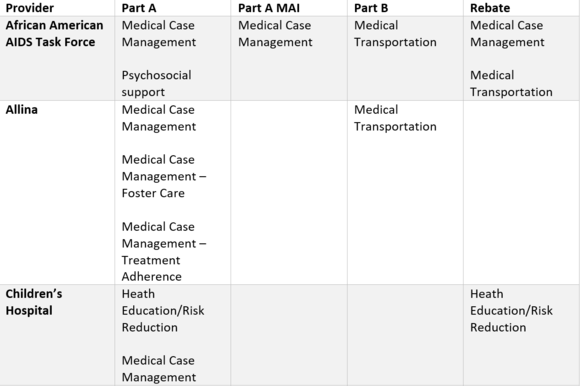 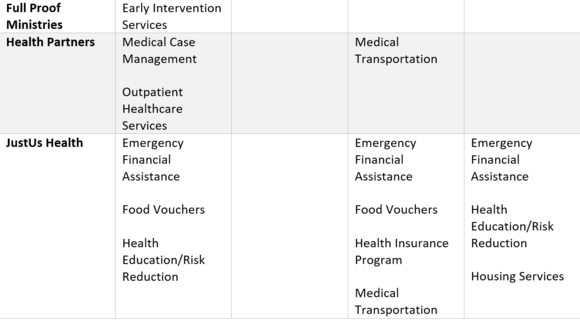 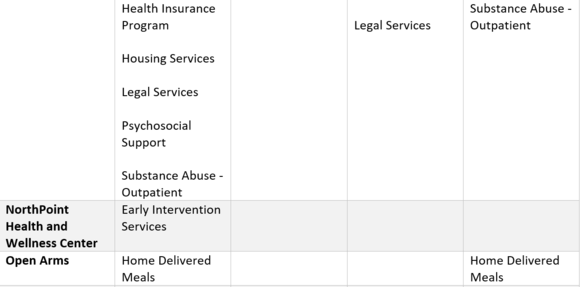 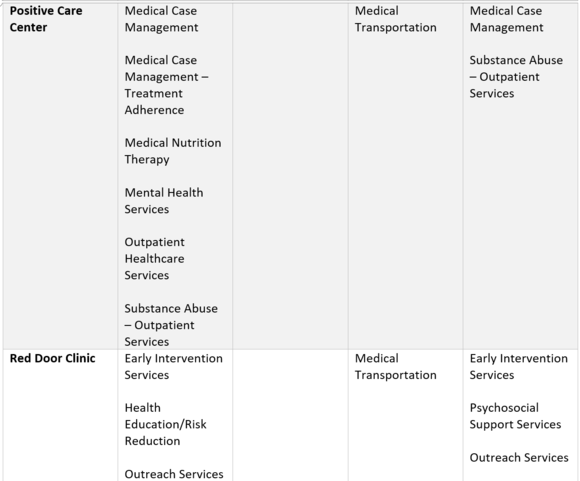  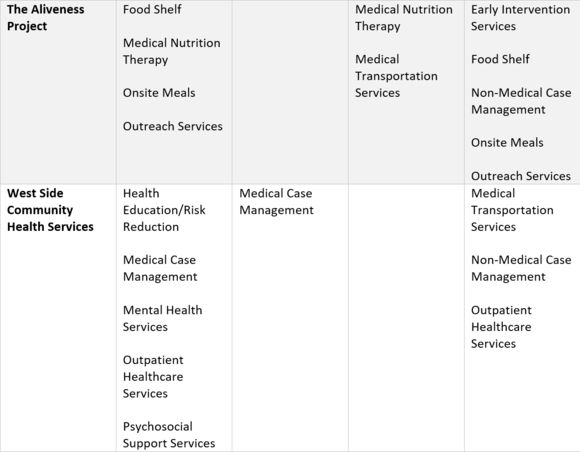
About us
The Ryan White newsletter is issued semiannually and provides information about HIV services planning, contract administration, quality managment, CAREWare updates and training opportunities. Your feedback and suggestions for future issues are appreciated.
|